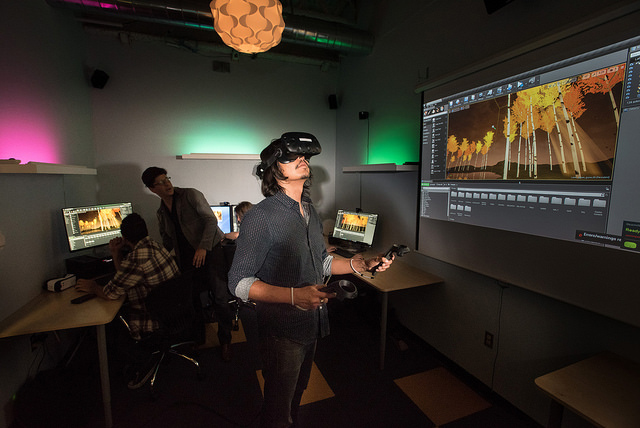One carbon atom and four hydrogen atoms bonded together make one molecule of methane.
Reading that in a textbook, seeing it in a picture or hearing a professor explain it doesn’t always give organic chemistry students the context to really understand what methane is.
Building a methane molecule in virtual reality, however, does. It allows students to experiment, make mistakes, manipulate the molecule and, perhaps most importantly, have fun doing it.
“It uses game theory and tricks you into learning,” said Giovanni Castillo, director of the Immersive + Interactive Virtual Reality Lab (IVR) at Northern Arizona University.
Castillo’s lab in the School of Communication opened a year ago, and in that time he’s had dozens of students take advantage of this advanced technology. Using virtual reality goggles that connect to phones students are able to explore different molecules and compounds and actively engage with organic chemistry, a sometimes difficult topic, as part of a groundbreaking research study with chemistry professors Clifford Coss and Edgar Civitello.
The idea is that allowing students to work with molecules in 3-D helps them to have a more complete understanding of the molecule and how it works. Building the molecules in VR also is more engaging than reading about it in a textbook, which may improve retention.
The study is too new to see results; virtual reality itself is so new that its effect on education has not been proven. Castillo wants to work with education and chemistry professors to create a curriculum that would provide data to quantify the technology’s use; he hopes to have that in place by 2018.
Other NAU researchers have collaborated with IVR as well, using the technology to research the psychological effects of VR environments on stress and anxiety; using digital reconstruction and VR to create an immersive reconstruction of a Maya city; and depicting the full span of the carbon cycle and the transfer of energy.
“When I thought about what this technology could do, I realized we could really contribute to learning and research, which is essentially the primary mission of NAU,” Castillo said.
In additional to the interdepartmental collaboration, Castillo wants to collaborate with organizations outside NAU to incorporate virtual reality in their studies. The Arizona Travel Bureau, U.S. Geological Survey and Nasa Ames have expressed interest in working with the lab, and he’s discussing partnerships with other universities who want to include VR in their research.
Plans to increase and expand the lab’s capabilities are already underway. The lab will be relocated to a 1,500-square-foot facility that will include a clinical lab, 30 workspaces and a full motion-capture suite, in addition to increasing the number of mobile units that are available for students to check out.
Karen Pugliesi, dean of the College of Social and Behavioral Sciences, believes VR is an important investment for the university to make as the global market becomes increasingly technology-driven.
“VR is an emerging technology that has many potential applications in journalism, research, health care, education, entertainment and many other arenas,” she said. “I see this as an investment in our students’ futures and as the development of powerful research and educational innovations. By its very nature, VR fosters collaboration and interdisciplinarity. These are the strategies that will ensure the college’s success.”
Experience virtual reality for yourself
What: Open house for the Immersive + Interactive Virtual Reality Lab
When: 3-5 p.m. March 8
Where: Room 239, School of Communication



